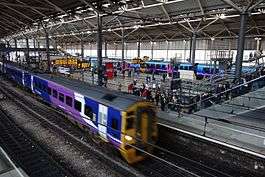Leeds railway station
| Leeds | |
|---|---|
|
Platforms 9-11, Leeds railway station | |
| Location | |
| Place | Leeds |
| Local authority | City of Leeds |
| Coordinates | 53°47′38″N 1°32′49″W / 53.794°N 1.547°WCoordinates: 53°47′38″N 1°32′49″W / 53.794°N 1.547°W |
| Grid reference | SE299331 |
| Operations | |
| Station code | LDS |
| Managed by | Network Rail |
| Number of platforms | 17 (National Rail) |
| DfT category | A |
|
Live arrivals/departures, station information and onward connections from National Rail Enquiries | |
| Annual rail passenger usage* | |
| 2010/11 |
|
| 2011/12 |
|
| 2012/13 |
|
| 2013/14 |
|
| 2014/15 |
|
| Passenger Transport Executive | |
| PTE | West Yorkshire (Metro) |
| Zone | 1 |
| History | |
| Key dates |
Opened 1938 Rebuilt 1967 Rebuilt 2002 |
| National Rail – UK railway stations | |
| * Annual estimated passenger usage based on sales of tickets in stated financial year(s) which end or originate at Leeds from Office of Rail and Road statistics. Methodology may vary year on year. | |
|
| |
Leeds railway station (also known as Leeds City railway station)[1][2][3][4] is the mainline railway station serving the city centre of Leeds in West Yorkshire, England. It is the third busiest railway station in the UK outside London (as of 2016).[5] It is located on New Station Street to the south of City Square, at the bottom of Park Row, behind the landmark Queens Hotel; it is one of 19 stations managed by Network Rail.[5]
Leeds is an important hub on the British rail network. The station is the terminus of the Leeds branch of the East Coast Main Line which provides high speed inter-city services to London and is an important stop on the Cross Country Route between Scotland, the Midlands and South West England connecting to major cities such as Birmingham, Glasgow, Edinburgh, Derby, Nottingham, Reading, Bristol, Exeter, Plymouth and Penzance. There are also regular inter-city services to major destinations throughout Northern England including Manchester, Liverpool, Newcastle and Sheffield. It is also the terminus for trains running on the scenic Settle to Carlisle Line. Future expansion will link the station to the proposed High Speed 2 (HS2) network.
Leeds is a major hub for local and regional destinations across Yorkshire such as to York, Scarborough, Hull, Doncaster and Sheffield. The station lies at the heart of the Metro commuter network for West Yorkshire providing services to Bradford, Wakefield, Dewsbury, Huddersfield and Halifax.
With nearly 29 million passenger entries and exits between April 2014 and March 2015, Leeds is the busiest railway station in the North of England and the third-busiest railway station in the United Kingdom outside London, after Birmingham New Street and Glasgow Central
Description


The railway station is situated on a hill falling from the south of the city to the River Aire and the Leeds and Liverpool Canal basin. Much of it is supported on Victorian brick-vaulted arches situated just off Neville Street which contain a centre consisting of cafés, restaurants, shops and exhibition spaces called Granary Wharf, known locally as the Dark Arches.
The railway station has 17 platforms, making it the largest by number of platforms in England outside London. There are 11 terminus and six through platforms. Most platforms are subdivided into up to four sections, i.e. 1a, 1b, 1c etc. All together including the numbers, there are 47 platforms.[6] Retail facilities in the station include coffee shops, fast food outlets, a bar, newsagents, chemists, and supermarkets. A British Transport Police station on New Station Street houses officers who police the West Yorkshire railway stations.
Leeds railway station retained manned ticket barriers through the 1990s until 2008 when they were replaced by automatic barriers by Northern to improve congestion around the barriers at peak times.[2][7]
- Platforms
Platform usage varies depending on operational circumstances but is generally:
- 1–5 – Bay platforms mostly used by MetroTrain services operated by Northern
- 6, 8 – 6 is a Bay Platform used for terminating Virgin Trains East Coast services from London, 8 is a through platform used for Virgin Trains East Coast services which both terminate and continue onward to Bradford, Harrogate and Skipton, as well as the early morning EC departure to Aberdeen.
- 9, 11, 12, 15, 16 – through platforms. CrossCountry services heading north to York and beyond depart from Platforms 9 or 11; services heading south use platform 12. Platforms 15 and 16 are used by north/east and south/westbound TransPennine Express services to Newcastle and York, and Huddersfield, Manchester Airport and Liverpool Lime Street.
- 7, 14 – Bay platforms used for local Northern services running north/east from Leeds.
- 10, 13, 17 – Bay platforms used for local and regional services running south/west to Manchester Victoria and Huddersfield, alongside southbound services towards Wakefield, Barnsley, Meadowhall, Sheffield and Nottingham.
Transport links
.jpg)
Leeds Interchange, located at the New Station Street exit, provides onward transport connections from the station. There are five bus stands serving Arriva, First and Yorkshire Tiger routes 4, 5, 16, 16A, 19, 19A, 40, 85, 87, 90, 757, 870 and DalesBus services. A 24-hour taxi rank also operates at the interchange.
Further bus stops are located on Neville Street below the railway station, as well as around City Square outside the railway station. Infirmary Street and Boar Lane Bus Points are a short walk for more bus connections.
Cycle hub
Leeds Interchange hosts one of the UK's first cycle hubs that allows a number of cycling services including repair, storage and rental. The facility opened in summer 2010 and is designed to encourage visitors and commuters into Leeds to continue their journey from the railway station by bike.[8] Its design is based on the Dutch cyclepoint concept.[9]
History
Past railway stations


.jpg)
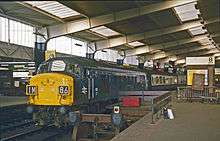

The railways arrived in Leeds in 1834 when the Leeds and Selby Railway (which became part of the North Eastern Railway) opened its line. It had a terminus at Marsh Lane east of the city centre. In 1840, the North Midland Railway (a constituent of the Midland Railway) constructed its line from Derby via Rotherham to a terminus at Hunslet Lane to the south. It was extended to a more centrally-located terminus at Wellington Street in 1846, known as Wellington Station.
Another railway station, Leeds Central (on Wellington Street), was opened in 1854 by the Manchester and Leeds Railway and the London and North Western Railway, or LNWR. The railway station became owned jointly by the LNWR and the North Eastern Railway, but other companies had powers to run trains there, including the Great Northern Railway and the Lancashire and Yorkshire Railway.
In 1869 New Station opened as a joint enterprise by the LNWR and the North Eastern Railway. It connected the former Leeds and Selby Railway Line to the east with the LNWR lines to the west. A mile-long connection was built, carried entirely on viaducts and bridges. New Station was built partially on a bridge over the River Aire adjacent to Wellington railway station.
The map to the right shows the variety of different railway lines in Leeds in 1913. Following the 1921 Railways Act, when railways in Great Britain were grouped into four companies, New Station was jointly-operated by the London, Midland and Scottish Railway (LMS) and the London and North Eastern Railway (LNER).
1938 rebuilding
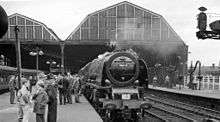
The first rationalisation occurred in 1938, when two railway stations (New and Wellington) were combined to form Leeds City Station, opening on 2 May that year. This was designed by LMS architect William Henry Hamlyn. The third railway station, Leeds Central, was unaffected by the change. Part of Wellington railway station later became a parcels depot. The north concourse and the Queens Hotel were built at this time.
1962 British Railways House
In 1962 British Railways House, now City House, was added to the railway station. It was designed by architect John Poulson providing British Railways with administrative buildings. The building became dated and hard to let before refurbishment in 2009. The building was lambasted in 1967 by poet John Betjeman who said it blocked all the light out of City Square, and was a testament to money with no architectural merit. In 2010 the building was bought by property company Bruntwood which plans to redevelop it to provide serviced offices, with a new look to the façade.
1967 rebuilding
In 1967 further remodelling of the site took place and trains using Central Railway Station were diverted into the City Railway Station which became the main railway station serving the city. Central Railway Station was closed and has been demolished. The viaduct leading to Central Railway Station is one of many disused viaducts near Leeds Railway Station. Engineering work included replacing 100-year-old bridges over the Leeds and Liverpool Canal, the construction of the south concourse & an overall roof, along with major platform & track layout alterations and the commissioning of a new power signal box to control the railway station area. At the time of this rebuilding, the railway station was served by 500 trains on a typical day, with 2.75 million passenger journeys a year. Wellington (or City North) became entirely devoted to parcels traffic at this time with the track layout extensively changed. The remaining Midland line trains which previously used City North station were diverted into the City South station, the former LNWR/NER 'New' station, and called simply Leeds from this time.
2002 rebuilding
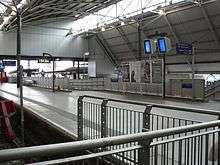

By the 1990s, the railway station's capacity was exceeded on a daily basis, and the 1967 design was deemed inadequate. Between 1999 and 2002, a major rebuilding project took place, branded as Leeds 1st. This project saw the construction of additional approach tracks at the western end of the railway station, improving efficiency by separating trains travelling to or from different destinations and preventing them from having to cross each other's routes. The railway station was expanded from 12 to 17 platforms, with the construction of new platforms on the south side, and reopening of the disused parcels depot to passengers on the north side. The majority of the track, points and signals were also replaced and the 1967 power box closed – control being handed over to the signalling centre at York. The most visible change to passengers, however, was the replacement of the 1967 metal canopy with a new glass roof, considerably increasing the amount of daylight on the platforms. A new footbridge was also provided, replacing the previous underpass. Ancillary improvements included a new multi-storey car park and railway station entrance, refurbishing the North Concourse and expanding retail facilities.
A small temporary railway station called Leeds Whitehall was provided to handle some services while the railway station was being remodelled. This has now been demolished.
2008 work
In 2008 automated ticket gates were installed in place of the human-controlled ticket checking, to speed up the passage of passengers. When the gates came into operation at the end of October 2008 they suffered from several faults including accepting invalid tickets.[10] An oversight on the part of Northern also meant that the gates were not compatible with West Yorkshire Metro Cards.[11]
Future
Leeds City railway station is the third busiest railway station outside London in England,[12] being a very busy railway station, expansion is needed. Passenger numbers at Leeds are expected to surge by 63% by 2029, meaning further expansion is necessary.[13]
Southern entrance
A £17.3 million southern entrance to allow for easier access from the south completed on 3 January 2016.[14][15] It widens the railway station's western footbridge and provide escalators, stairs and lifts to a partial deck over the River Aire in an iconic structure. The deck provides access to either side of the river for passengers to access Granary Wharf and Little Neville Street or Holbeck. It contains extra ticket vending machines and cycle storage. Around 20%[14] of passengers are expected to use the new entrance.[16][17]
Expansion
Plans are being drawn up to expand the railway station's capacity with new lines and platforms alongside platform one in the Riverside Car Park on the site of the original Leeds Wellington railway station to cater for predicted growth. Also Metro announced plans to replace platforms 1A, 1B and 1C with three separate platforms using the car park next to the platform 1's. This would increase platform numbers from 17 to 19.
South concourse
Network Rail plans to improve the south concourse by opening up the skylights to allow in natural light. The first phase of works will aim to reduce congestion. Consideration will be given to a mezzanine level for retail units. Network Rail has said that it "is looking at the feasibility of the provision of a new roof to the concourse. The latter scheme is one that will be taken forward in conjunction with Bruntwood" in connection with the redevelopment of City House.[18]
Future service
In June 2014, Network Rail accepted Alliance Rail t/a Great North Western Railway Company (GNWR) to operate services between London Euston and Leeds via Warrington Bank Quay and Huddersfield with six services per day in both directions. The services were proposed to start in 2017 using Pendolino trains.[19][20] However, in January 2015 the proposed services were rejected.
Virgin Trains East Coast plan to operate direct services between London Kings Cross and Huddersfield via Leeds from 2019.[21]
As part of the new Arriva Rail North franchise, from December 2017 there will be a new hourly service to Chester, calling at Bradford, Manchester and Warrington Bank Quay.[22] New services to Bridlington via Hull will also be introduced and those to Nottingham will be re-routed via Wakefield Westgate rather than via Barnsley (saving 20+ minutes journey time) and extended to/from Bradford Interchange.[23] These new routes will be marketed under the "Northern Connect" brand and use new DMUs.
HS2 platforms

The original plans for HS2 proposed a separate new station in Leeds to the south of the River Aire at New Lane.[24][25] However, a later review in November 2015 instead recommends that HS2 platforms be added to the existing station.[26] These would attach to the southern part of the existing station building, and span the river in a North-South alignment to create a 'T' shape. Whilst not directly linking the rail lines, it will allow a common concourse for easy interchange between high speed and classic rail services. These plans were approved by the Government in November 2016.[27][28]
Services
The railway station is served by train operators, Virgin Trains East Coast, CrossCountry, TransPennine Express, Northern and East Midlands Trains. It is also the hub of the MetroTrain network in West Yorkshire, being the terminus of the following lines:
- The Leeds branch of the East Coast Main Line to London Kings Cross
- Midland Main Line to London St Pancras
- Airedale Line to Skipton/Heysham Port/Morcambe/Carlisle
- Caldervale Line to Manchester Victoria/Blackpool North/Huddersfield
- Hallam Line to Sheffield
- Harrogate Line to York/Knaresborough
- Huddersfield Line to Huddersfield
- Pontefract Line to Goole
- Wakefield Line to Doncaster/Sheffield
- Wharfedale Line to Ilkley
- Leeds-Bradford Lines to Bradford
| Leeds Lines | ||||||||||||||||||||||||||||||||||||||||||||||||||||||||||||||||||||||||||||||||||||||||||||||||||||||||||||||||||||||||||||||||||||||||||||||||||||||||||||||||||||||||||||||||||||||||||||||||||||||||||||||||||||||||||||||||||||||||||||||||||||||||||||||||||||||||||||||||||||||||||||||||||||||||||||||||||||||||||||||||||||||||||||||||||||||||||||||||||||||||||||||||||||||||||||||||||||||||||||||||||||||||||||||||||||||||||||||||||||||||||||||||||||||||||||||||||||||||||||||||||||||||||||||||||||||||||||||||||||||||||||||||||||||||||||||||||||||||||||||||||||||||||||||||||||||||||||||||||||||||||||||||||||||||||||||||||||||||||||||||||||||||||||||||||||||||||||||||||||||||||||||||||||||||||||||||||||||||||||||||||||||||||||||||||||||||||||||||||||||||||||||||||||||||||||||||||||||||||
|---|---|---|---|---|---|---|---|---|---|---|---|---|---|---|---|---|---|---|---|---|---|---|---|---|---|---|---|---|---|---|---|---|---|---|---|---|---|---|---|---|---|---|---|---|---|---|---|---|---|---|---|---|---|---|---|---|---|---|---|---|---|---|---|---|---|---|---|---|---|---|---|---|---|---|---|---|---|---|---|---|---|---|---|---|---|---|---|---|---|---|---|---|---|---|---|---|---|---|---|---|---|---|---|---|---|---|---|---|---|---|---|---|---|---|---|---|---|---|---|---|---|---|---|---|---|---|---|---|---|---|---|---|---|---|---|---|---|---|---|---|---|---|---|---|---|---|---|---|---|---|---|---|---|---|---|---|---|---|---|---|---|---|---|---|---|---|---|---|---|---|---|---|---|---|---|---|---|---|---|---|---|---|---|---|---|---|---|---|---|---|---|---|---|---|---|---|---|---|---|---|---|---|---|---|---|---|---|---|---|---|---|---|---|---|---|---|---|---|---|---|---|---|---|---|---|---|---|---|---|---|---|---|---|---|---|---|---|---|---|---|---|---|---|---|---|---|---|---|---|---|---|---|---|---|---|---|---|---|---|---|---|---|---|---|---|---|---|---|---|---|---|---|---|---|---|---|---|---|---|---|---|---|---|---|---|---|---|---|---|---|---|---|---|---|---|---|---|---|---|---|---|---|---|---|---|---|---|---|---|---|---|---|---|---|---|---|---|---|---|---|---|---|---|---|---|---|---|---|---|---|---|---|---|---|---|---|---|---|---|---|---|---|---|---|---|---|---|---|---|---|---|---|---|---|---|---|---|---|---|---|---|---|---|---|---|---|---|---|---|---|---|---|---|---|---|---|---|---|---|---|---|---|---|---|---|---|---|---|---|---|---|---|---|---|---|---|---|---|---|---|---|---|---|---|---|---|---|---|---|---|---|---|---|---|---|---|---|---|---|---|---|---|---|---|---|---|---|---|---|---|---|---|---|---|---|---|---|---|---|---|---|---|---|---|---|---|---|---|---|---|---|---|---|---|---|---|---|---|---|---|---|---|---|---|---|---|---|---|---|---|---|---|---|---|---|---|---|---|---|---|---|---|---|---|---|---|---|---|---|---|---|---|---|---|---|---|---|---|---|---|---|---|---|---|---|---|---|---|---|---|---|---|---|---|---|---|---|---|---|---|---|---|---|---|---|---|---|---|---|---|---|---|---|---|---|---|---|---|---|---|---|---|---|---|---|---|---|---|---|---|---|---|---|---|---|---|---|---|---|---|---|---|---|---|---|---|---|---|---|---|---|---|---|---|---|---|---|---|---|---|---|---|---|---|---|---|---|---|---|---|---|---|---|---|---|---|---|---|---|---|---|---|---|---|---|---|---|---|---|---|---|---|---|---|---|---|---|---|---|---|---|---|---|---|---|---|---|---|---|---|---|---|---|---|---|---|---|---|---|---|---|---|---|---|---|---|---|---|---|---|---|---|---|---|---|---|---|---|---|---|---|---|---|---|---|---|---|---|---|---|---|---|---|---|---|---|---|---|---|---|---|---|---|---|---|---|---|---|---|---|---|---|---|---|---|---|---|---|---|---|---|---|---|---|---|---|---|---|---|---|---|---|---|---|---|---|---|---|---|---|---|---|---|---|---|---|---|---|---|---|---|---|---|---|---|---|---|---|---|---|---|---|---|---|---|---|---|---|---|---|---|---|---|---|---|---|---|---|---|---|---|---|---|---|---|---|---|---|---|---|---|---|---|---|---|---|---|---|---|---|---|---|---|---|---|---|---|---|---|---|---|---|---|---|
Legend | ||||||||||||||||||||||||||||||||||||||||||||||||||||||||||||||||||||||||||||||||||||||||||||||||||||||||||||||||||||||||||||||||||||||||||||||||||||||||||||||||||||||||||||||||||||||||||||||||||||||||||||||||||||||||||||||||||||||||||||||||||||||||||||||||||||||||||||||||||||||||||||||||||||||||||||||||||||||||||||||||||||||||||||||||||||||||||||||||||||||||||||||||||||||||||||||||||||||||||||||||||||||||||||||||||||||||||||||||||||||||||||||||||||||||||||||||||||||||||||||||||||||||||||||||||||||||||||||||||||||||||||||||||||||||||||||||||||||||||||||||||||||||||||||||||||||||||||||||||||||||||||||||||||||||||||||||||||||||||||||||||||||||||||||||||||||||||||||||||||||||||||||||||||||||||||||||||||||||||||||||||||||||||||||||||||||||||||||||||||||||||||||||||||||||||||||||||||||||||
| ||||||||||||||||||||||||||||||||||||||||||||||||||||||||||||||||||||||||||||||||||||||||||||||||||||||||||||||||||||||||||||||||||||||||||||||||||||||||||||||||||||||||||||||||||||||||||||||||||||||||||||||||||||||||||||||||||||||||||||||||||||||||||||||||||||||||||||||||||||||||||||||||||||||||||||||||||||||||||||||||||||||||||||||||||||||||||||||||||||||||||||||||||||||||||||||||||||||||||||||||||||||||||||||||||||||||||||||||||||||||||||||||||||||||||||||||||||||||||||||||||||||||||||||||||||||||||||||||||||||||||||||||||||||||||||||||||||||||||||||||||||||||||||||||||||||||||||||||||||||||||||||||||||||||||||||||||||||||||||||||||||||||||||||||||||||||||||||||||||||||||||||||||||||||||||||||||||||||||||||||||||||||||||||||||||||||||||||||||||||||||||||||||||||||||||||||||||||||||
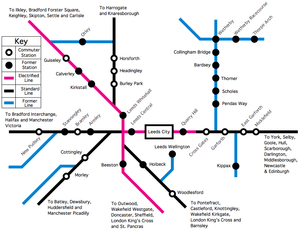
References
- ↑ "Leeds Station". Network Rail Virtual Archive. Network Rail. 7 March 2012. Retrieved 3 December 2015.
- 1 2 "Leeds Railway Station". Railway-Technology. Retrieved 3 December 2015.
- ↑ "Automatic ticket gates at Leeds City Station".
- ↑ "leedsliveitloveit". leedsliveitloveit. Retrieved 3 May 2014.
- 1 2 "Commercial information". Our Stations. London: Network Rail. April 2014. Retrieved 12 April 2014.
- ↑ Yonge, John (September 2006) [1994]. Jacobs, Gerald, ed. Railway Track Diagrams 2: Eastern (3rd ed.). Bradford on Avon: Trackmaps. map 37A. ISBN 0-9549866-2-8.
- ↑ "Travel Tools – Automatic ticket gates". Northern Rail. Retrieved 3 May 2014.
- ↑ "Bicycle hire and storage scheme opens at Leeds Station". BBC Leeds and West Yorkshire. 27 September 2010. Retrieved 3 December 2015.
- ↑ http://www.northernrail.org/pdfs/press/Cyclepoint_Brochure.pdf
- ↑ "Barriers accept wrong tickets". BBC News. 18 November 2008. Retrieved 3 May 2014.
- ↑ "Your Views: The problems with Leeds railway station's new ticket barrier". Yorkshire Evening Post. 30 October 2008. Retrieved 3 May 2014.
- ↑ "Station usage 2013–14 infographic" (PDF). Office of Rail Regulation. Retrieved 16 February 2015.
- ↑ "Network Rail unveils plans for Leeds station | Global Rail News". Rail.co. Retrieved 3 May 2014.
- 1 2 "New station entrance given approval" (Press release). 31 October 2013. Retrieved 6 November 2013.
- ↑ "Leeds Rail Station - new southern entrance (LSSE)".
- ↑ Eversheds LLP, on behalf of Network Rail and West Yorkshire Passenger Transport Executive. "THE LEEDS RAILWAY STATION (SOUTHERN ENTRANCE)ORDER Concise Statement of Aims" (PDF). Retrieved 17 June 2012.
- ↑ "Have your say on Leeds Station Southern Entrance plans" (Press release). 2 December 2011. Retrieved 17 June 2012.
- ↑ "City House" (PDF). Bruntwood. p. 10. Retrieved 17 June 2012.
- ↑ "GNWR granted access to West Coast main line". Global Rail News.
- ↑ http://www.alliancerail.co.uk/wp-content/themes/alliance/GNWR%20Application/track%20access%20contract/track%20access%20contract.pdf
- ↑ "Consortium to buy East Coast trains announced". ITV News. 27 November 2014. Retrieved 3 December 2015.
- ↑ "Northern franchise improvements". p. Chester to Leeds.
- ↑ £1.2 billion upgrade for North as Arriva wins Northern and First retains TransPennine Express Clinnick, Richard; Rail Magazine article 9 December 2015; Retrieved 17 December 2015
- ↑ "Phase Two: Leeds". HS2. Retrieved 3 May 2014.
- ↑ https://www.gov.uk/government/uploads/system/uploads/attachment_data/file/69036/hs2-arp-lr0-dr-rt-55222_3-0.pdf
- ↑ "The Yorkshire Hub" (PDF). Department for Transport. p. 10. Retrieved 30 November 2015.
- ↑
- ↑
Further reading
- Haigh, Phil (25 February – 10 March 1998). "A station for the 21st century...". RAIL. No. 325. EMAP Apex Publications. pp. 20–24. ISSN 0953-4563. OCLC 49953699.
External links
| Wikimedia Commons has media related to Leeds railway station. |
- Station information on Leeds railway station from Network Rail
- Train times and station information for Leeds railway station from National Rail
- http://www.networkrail.co.uk/VirtualArchive/leeds-station – history of the station from Network Rail archives
